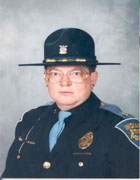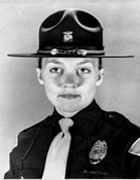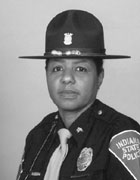Since 1933, among the many prerequisites to become a trooper, being a man was always one of the main requirements. All that changed in 1973 when for the first time, the Indiana State Police began accepting applications from females. Superintendent Robert Konkle told the Indianapolis Star, “But they must meet the same physical qualifications as men.” At that time the state police rules required that applicants had to be at least 5 feet 9 inches and not more than 6 feet 5 inches in height, weight had to be at least 150 pounds and the applicant had to be between 21 and 35 years of age. The height and weight requirement automatically disqualified most women. Superintendent Konkle also said, “Any woman accepted to recruit school will go through the same training as a man. She will have to do the same number of pushups as a man. If she can’t lift her own weight, she can’t be a trooper.”
In the summer of 1975 the Department asked for volunteers among ISP’s civilian female staff to participate in a series of tests that were designed to help determine the physical criteria for female trooper applicants. Two committees were selected; one from within the Indiana State Police and one consisting of representatives from Indiana, Purdue, and Ball State Universities. Both committees submitted their findings to the University of Chicago which would evaluate all data submitted and then create a pre-employment screening test.
It wasn’t until 1975 however, that a woman was even interviewed to become a trooper. Karen Butt was the first female to be interviewed for a job as a trooper. She had applied for a recruit class that was scheduled to be held in early 1976 and that class would be the first ISP recruit class to have female recruits among its ranks. Although she wasn’t accepted for that class, she was called back later that year and would go on to attend the next recruit school and become a trooper. In June of 1976 however, a class graduated that started with four females and three endured the grueling training and graduated to become the first female Indiana State Troopers. Those “trailblazers” were Joyce Blanford, Patricia King, and Joan Malayter.
 |  |
 |  |
While the first female troopers were able to prove their mettle in recruit school, they had to continue to overcome other hurdles in the field. In the mid 1970’s, new recruits were required to “live” at the post during their field training period. At that time ISP didn’t pay overtime so the rookie troopers had to work in the post during the day learning radio procedures and post administrative duties and then at night they were in the field riding with experienced troopers. Sleeping arrangements had to be modified to separate the rookie female troopers from the males. Among other concerns were those of the wives of troopers worrying about their husbands working at night with female troopers. Of course there were other issues that were simply the result of ignorance or bigotry. For example, Karen Butt recalls many times answering the phone at the post and the caller requesting to speak to a “real” trooper since it was a female who answered the phone.
Another issue that presented itself was the possibility of a female trooper becoming pregnant. Jill Rice, another of the early female troopers, was assigned to the Charlestown Post when she was a rookie. In the 1970’s there was no such thing as the Family Medical Leave Act or no maternity leave mandate. When Jill became pregnant, the Department had no policies in place to deal with such circumstances.
Over the years the Indiana State Police has hired numerous female troopers who have distinguished themselves among the Department and are now accepted as equals. Currently there are 59 female ISP troopers who are spread throughout the state and among the various ranks and specialty positions. Currently there are females holding supervisory and command positions up to and including the rank of major within the Indiana State Police. Throughout the years ISP has had and still has female troopers serving as members of the Tactical Intervention Platoon (formerly known as Riot Platoon), Field Training Officers, SCUBA Divers, Defensive Tactics Instructors, Firearms Instructors, and Emergency Vehicle Operations Instructors.
Because of the tenacity and dedication of those first female “pioneers” blazing the trail for the future, being a female applicant for a position as an Indiana State Trooper today is not really any different than that of a male applicant. Female troopers are now accepted with much less skepticism and are very much an established part of the Indiana State Police.
